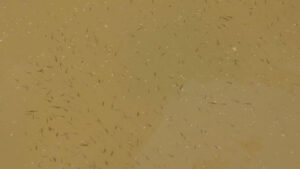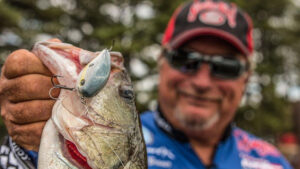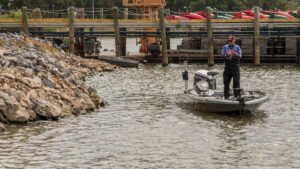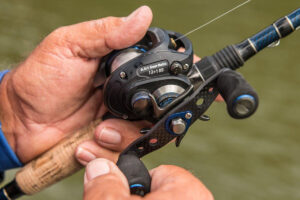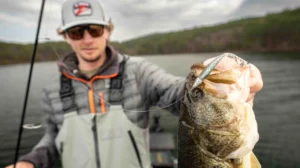The post-spawn period can be a fairly deflating time of year for anglers. After a few months of excellent and, if we’re honest, relatively easy bass fishing, the action begins to die down as the annual romance of our slime-covered friends comes to an unfortunate end. The big females are tired, ornery and dispersed throughout the lake while their smaller male counterparts are doing their best to guard newly hatched fry.
Essentially, the aggressive bass behavior of months past has spoiled us. Now it’s time to put our heads down, roll up our sleeves and get to work. Welcome to one of the most finicky times of the year. Welcome to the post-spawn.
According to bass fishing legend Denny Brauer, however, squarebill crankbaits can be an outstanding remedy to subpar post-spawn bass fishing. Not only do these popular lures allow him to cover and eliminate water quickly, but they can also generate vicious reaction strikes from otherwise lethargic bass.
In order to maximize your success, there are several important factors to consider.
- Primary advantages
- Stained water and shallow bass
- Effective colors
- Size selection
- High-percentage areas
Primary advantages of a squarebill
All crankbaits are not created equal. In fact, there are seemingly endless bill designs, body shapes and sounds from which to choose. While you can enjoy moderate success with a standard round-billed shallow crankbait, the unique design of a squarebill is hugely advantageous throughout the post-spawn season.
- Efficiency— “Squarebill crankbaits are specifically designed to avoid annoying hang-ups throughout the day,” Brauer said. “With just a steady retrieve, they’ll bounce and deflect off of hard cover which maximizes your efficiency on the water. Post-spawn females are normally isolated—they haven’t schooled up for the summer just yet. So this means we have to cover a lot of water to find ‘em and a squarebill is just perfect for this application.”
- Reaction strikes— The spawning period is an awfully stressful time for bass, especially the females. So when their annual spawn comes to an end, they need some time to rest and recover. This is commonly referred to this as the “post-spawn funk” because their feeding windows often become very small and hard to pinpoint. The erratic action, deflection qualities and water displacement of squarebills, however, will often trigger instinctual reaction strikes. In other words, even when those big females aren’t on a major feed, they can’t stop themselves from attacking a well-placed squarebill. They’re biologically programmed to be opportunistic feeders.
- Anyone can do it— “This is a perfect bass fishing lure for a beginner angler to use,” Brauer said. “You don’t have to get too fancy with your retrieve—just cast and wind for the most part. This time of year, I’ve noticed that a varying retrieve doesn’t necessarily mean more bites. A fast, steady retrieve is hard to beat throughout the post-spawn and depending upon the mood of the fish, you can adjust accordingly. If you’re noticing fish follow the crankbait in clear water, speed your retrieve even more. Conversely, if you find yourself in dirty water, you can often slow your retrieve to get a few more bites. It’s quite simple, but that’s certainly not a bad thing.”
Dirty water means shallower bass
While squarebill crankbaits can certainly be an effective choice in clear water, Brauer believes they’re tailor-made for close combat in dirty water. Fortunately, frequent spring rainstorms add color to many of the country’s lakes, making these lures a major player.
“In dirty water, bass are more comfortable in the shallows,” Brauer said. “Because the low-visibility inhibits their sense of sight, they’re probably not going to be swimming around in deep water blindly looking for a meal. Shallow water puts them in close quarters with their preferred forage and makes it easier for them to feed. These bass are relying heavily on their lateral lines to feed and the water displacement and vibration of a squarebill makes it easy for bass to locate and attack it.”
Four colors to cover all of your bases
When you take a walk down the crankbait aisle of your local tackle shop, it’s easy to become overwhelmed. You’ll see all kinds of colors that, quite frankly, look more like novelties than something a bass would actually eat. So how in the world do you know which colors to buy?
Brauer’s Strike King KVD Squarebill Crankbait collection is surprisingly simple. Throughout his storied career, he’s developed confidence in four primary color patterns that will work in almost any situation imaginable.
- Sexy Blueback Herring— “This has absolutely become my favorite color in recent years,” Brauer said. “When you have a lot of water clarity, it’s incredibly difficult to beat. It’s not overpowering to the fish. It’s a very natural color pattern that has worked at almost every lake I’ve fished. When I’m throwing a squarebill in clear water, you can bet this is the color I have tied on.”
- Sexy Shad— This might just be the most popular squarebill colors of recent years and there’s a darn good reason—it catches fish in most water clarity situations. Brauer prefers this color when the water has a slight stain to it because although it maintains the primary colors of a natural shad, the added streak of chartreuse enhances visibility and gives the bass an easy target to hone in on.
- Chartreuse Black Back— “When I’m fishing dirty water with very low visibility, I’m almost always using this color,” Brauer said. “It’s bright enough for bass to see it and the contrast created between the chartreuse sides and jet-black back imitates the natural flash of a baitfish extraordinarily well. It might look a little gaudy to the human eye, but remember—everything is significantly muted in dirty water, so it looks very natural to the bass.”
- DB Craw— Don’t let the name of this color fool you. Although it’s tempting to consider this pattern a crawfish-only imitator, Brauer specifically designed it to mimic three particular types of forage—bream, perch and of course, crawfish.
Straightforward size selection
Much like the color selection conundrum that many anglers face, you’ll also notice a wide array of sizes when you’re shopping for squarebills. You’ll see a little bit of everything— tiny, small, medium and some darn-near the size of your hand. So is it really that complicated?
Not necessarily according to Brauer. He primarily uses three sizes throughout the post-spawn period and he makes his decision based on two simple factors—conditions and the size of the bass.
- 1.0— “Post-frontal bass are notorious for being stubborn,” Brauer said. “They can get in a really negative mood, but that doesn’t mean they won’t choke a squarebill. I like to use a small 1.0 size on 12-pound Seaguar Tatsu Fluorocarbon when I’m faced with tough conditions. The bass may not eat a big plug on these days but it’s amazing what a simple size change can do.”
- 1.5— Probably the most popular size option for bass anglers, Brauer uses the 1.5 size on 15-pound Seaguar Tatsu Fluorocarbon as a “happy medium” in lightly stained water. He believes it’s an excellent starting point for anglers because not only will it catch lots of bass, but it will also catch big ones as well.
- 2.5— “If I’m on a fishery that’s known for its big bass, I’m going to dial it up and tie on a 2.5 size on heavy 20-pound Seaguar Tatsu,” Brauer said. “There’s no denying that big bass favor big baits—they’re smart. They want more bang for their buck when they feed, so if they’re going to expend the energy to chase down a meal, they want to make sure they get their fill.”
5 post-spawn squarebilling hotspots
At this point, our squarebill knowledge is up to par. We understand the advantages, optimal colors and size selection but now we have to know where to throw ‘em, right? Instead of haphazardly casting towards anything that “looks good”, post-spawn squarebill fishing can be a little more specific than other times of the year.
But it’s not as daunting as it may seem. Regardless of the body of water, Brauer expects you to have success fishing these 5 particular hotspots.
- Riprap— “A lot of folks tend to take riprap for granted,” Brauer said. “But man, it’s an incredible place to catch post-spawners. As they start to pull out of their spawning areas, they have to go through these funnel areas before they reach their summertime haunts. If you can parallel some windy riprap and keep covering water, you’ll definitely catch some nice fish.”
- Deep cover adjacent to spawning grounds— While the males hang back and guard fry throughout the early stages of the post-spawn, the big females move towards deeper, isolated cover according to Brauer. They won’t go far and they’re fairly easy to locate, but they’ll suspend on this cover and become difficult to catch with bottom-contact presentations. Any cover you can find at the mouths of spawning pockets, whether it be boat docks or laydowns, you’ll have an excellent chance at fooling these females with a squarebill.
- Standing timber— “I’ve had some excellent post-spawn success fishing squarebills in standing timber,” Brauer said. “The timber might be in 15 to 20 feet, but remember—these post-spawners like to suspend high in the water column. I simply find spawning areas and look for nearby standing timber in the first deep water adjacent to them. The gnalier trees with the good Y-shaped forks are awesome.”
- Shallow grass near deep water— “I like to graph a lot of ledges with my Humminbird 1199 and and find shallow ledges with some short grass growing on them,” Brauer said. “If they’re in 3 to 6 feet and drop into the river channel with some hydrilla nearby, it’s going to be a post-spawners last stopping place before they move deep for the summer.”
- Shad spawns— While not necessarily a concrete “location”, Brauer couldn’t leave out the importance of late-spring shad spawns. He’s doesn’t look for cover as much as he looks for shad activity because quite honestly, the shad spawn can occur in a number on places such as grass lines, boat docks, riprap and seawalls. According to him, if you’re not fishing the shad activity in the first hour of a post-spawn day, you’re significantly hurting your chances of catching giant bass.
Don’t let the “post-spawn funk” get you down this season. With a basic understanding of proper squarebill selection and potential bass-holding areas, you’re bound to run into a few good ones with your favorite crankbait in-hand.




